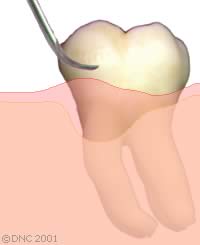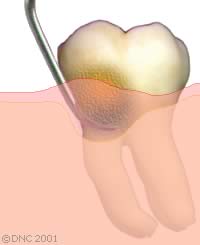Okanagan Periodontics
Treatment of Periodontal Disease (Gum Disease) in Kelowna
Treatment of Periodontal Disease (Gum Disease) Near You
Periodontal disease, or gum disease, is preceded by several warning signs. Bad breath can be an early warning sign of gum disease, along with receding gum lines, heightened tooth sensitivity, and even tooth loss. Your dentist will usually notice these early-stage symptoms and will alert you to various risk factors in your lifestyle. If there are signs of periodontal disease that require treatment, your dentist may refer you to a periodontist (a dentist specialized in treating gum disease). Dr. Faigan is an experienced periodontist in the Okanagan region of BC.
There are two main types of treatments that can be offered for gum disease: surgical and non-surgical. Non-surgical procedures are often performed by a Registered Dental Hygienist (RHD), while surgical procedures are often performed by a periodontist.
Non-Surgical Treatment of Gum Disease In Kelowna
There are several non-surgical treatments for gum disease that are effective for non-advanced cases of periodontitis. Registered Dental Hygienists (RDH) often perform these treatments with the periodontist consulting on the procedure.
Root Scaling
Root scaling uses specialized instruments, such as a laser or ultrasonic device, to remove hardened tartar and bacteria from the surface of your teeth beneath the gum line. The deeper your gum pockets grow, the more challenging it is to keep them clean. The specialized techniques and instruments that RDHs use can reach these problematic places to keep them clean and help them heal. Root scaling uses local anesthesia so that you won’t feel any pain during the procedure.
Root Planing
Root planing involves smoothing out the surface of the tooth’s roots. Creating a smooth surface helps prevent tartar buildup and inflammation of the surrounding gums. The smoother the roots are, the greater the chance there is for the gums to reattach to the tooth’s surface. Root planing involves local anesthesia so you can feel comfortable and pain-free throughout the treatment.
Antibiotics
Another non-surgical treatment for gum disease is antibiotics. Both topical and oral antibiotics can help control and eliminate bacterial infections of your gums. Topical options include mouth rinses or gel form inserted deep into the gum pockets. For stubborn infections, oral antibiotics are prescribed. When a topical antibiotic is not effectively stopping the infection, oral medication is often prescribed at the same time.
Surgical Treatment of Gum Disease
When gum disease advances into later stages, several surgical procedures can be used to treat the problem. Periodontists are specially trained and experienced in diagnosing and treating gum disease, as well as in surgically placing dental implants. The nature of your periodontitis and how it has affected your mouth, teeth, and soft tissues will determine which surgical treatment is proper for you. Dr. Faigan will assess your condition and provide you with the best treatment options for your oral health.
Flap Surgery or Pocket Reduction Surgery
If the pockets between your teeth and gums become very deep, our periodontist may recommend flap surgery to reduce the depth and make it easier to clean your mouth. During flap surgery, the periodontist makes tiny incisions into your gums to pull them back and clean the bottoms of your teeth and roots. If you’ve suffered bone loss from gum disease, the periodontist will recontour the bone before suturing the gum securely back into place. Once the area has healed, your gum pockets will be smaller and easier to keep clean, which also makes it easier to fight the bacteria causing the gum disease.
Soft Tissue Grafts
When a patient experiences gum loss or a receding gum line, the cause may be genetic or a result of gum disease. The solution for weakened gums is a soft tissue graft performed by a periodontist. Your gum helps keep your teeth in position and protects your sensitive teeth roots from exposure to the elements. During a soft-tissue graft, the periodontist will take a piece of tissue from the roof of your mouth or palate and attach it to the weakened gum site. If it’s not possible to take a sample from the palate, the periodontist will use another soft tissue. Soft tissue grafts help cover exposed tooth roots and make the area appear more attractive.
Bone Grafting
Advanced periodontitis can break down and destroy the bone around the tooth root. The solution for bone loss is a bone graft, which involves taking bone fragments from your own bone, a synthetic bone material, or donated bone. Reinforcing the bone structure in your jaw and teeth helps hold your teeth in the proper position and provides a platform for natural bone regrowth.
Guided Tissue Regeneration
Guided tissue regeneration is an alternative to bone grafting. Guided tissue regeneration uses biocompatible fabric to fill the gap between the fragments of bone that bacteria have destroyed. The material allows the bone to reconnect while preventing unwanted tissue from developing in the space. Your periodontist will recommend this type of treatment when the bone damage is mild to moderate.
Tissue Stimulating Proteins
Periodontitis affects the health of the teeth, roots, and enamel layer. When there is sufficient damage to the tooth’s outer layer, a protein gel can be applied to the root of the tooth. This protein gel helps stimulate enamel development and the growth of healthy bones and tissues.
Prevention of Gum Disease
The best strategy for preventing periodontal disease or reversing mild cases of gum disease is good oral hygiene. A daily practice of brushing your teeth twice a day and flossing between your teeth reduces the amount of plaque that can build up on your teeth. If your dentist identifies you as a high risk for gum disease, you may also want to use a mouth rinse designed to target plaque and tartar.
Making routine check-ups and professional teeth cleaning appointments helps get rid of tartar and plaque buildup on your teeth and around your gum lines. Your dentist will also take routine measurements of the depths of gum pockets in key areas of your mouth. They will measure these pockets to watch for signs that they are growing deeper and putting you at greater risk for gum disease. Regular check-ups also allow your dentist to catch the early signs of gum disease and give you a timely referral to a periodontist when needed.
Periodontal Services in Kelowna
At Okanagan Periodontics, we provide an extensive list of periodontic treatments, procedures, and surgeries. Explore our services page to learn more.
Remember


